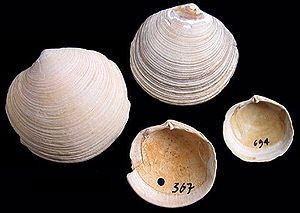Lucinida
| Lucinida | ||||||||||||
|---|---|---|---|---|---|---|---|---|---|---|---|---|

Northern moon shell ( Lucinoma borealis ) |
||||||||||||
| Systematics | ||||||||||||
|
||||||||||||
| Scientific name | ||||||||||||
| Lucinida | ||||||||||||
| Gray , 1854 |
The Lucinida are an order of the mussels (Bivalvia). The representatives of the order are characterized by the fact that they mostly live in symbiosis with chemoautotrophic bacteria . The oldest representatives of the Lucinida occur in Ordovician layers ( Babinka and Coxiconcha ).
features
The small to very large, equally-folded housings are round, egg-shaped, elliptical to rounded-triangular in outline. They are usually only slightly unequal. The vertebrae are usually small, tapering and ortho- or prosogyr arched.
The ligament lies externally behind the vertebrae on sunken nymphs . The lock originally consisted of two cardinal teeth in both flaps. In the left valve there are two anterior and posterior lateral teeth on top of each other, in the right valve one anterior and posterior lateral tooth is developed. In many species, however, the lock teeth are differently or completely reduced. The two sphincters are more or less clearly unequal in size. The anterior sphincter is often more or less elongated and narrow; it separates at an angle from the surface line. The surface line is complete, not indented, often wide and somewhat modified.
The shell is aragonitic . The outer layer is combined prismatic, the middle layer consists of cross lamellas, and the inner layer is complex-cross lamellar. The surface usually shows an ornamentation parallel to the edge consisting of fine to coarse growth strips, ribs and lamellas. There are also almost smooth forms and types with different patterns. In some forms, more or less distinct keels run from the vertebrae to the anterior or posterior end of the ventral margin.
Geographical distribution, habitat and way of life
The order is spread all over the world. Most species, however, occur in tropical, subtropical or warm temperate seas. They live almost exclusively in habitats with a high supply of organic material, such as seagrass meadows and mangroves, or on cold seas , in which hydrocarbons penetrate the sediment surface. Seagrass meadows capture organic detritus. The sediment has higher rates of sulphide reduction and sulphide retention than the surrounding non-vegetated sediments. Mangrove forests are also a shallow water ecosystem with a very high supply of organic matter. Most species of the Lucinidae therefore live in water depths of less than 100 m. However, there are similar conditions for hydrocarbon escapes to the sediment surface in deeper sea areas. More recent investigations have therefore shown an astonishingly high diversity of this group, even in larger, bathy sea depths.
The animals usually live moderately deeply buried, more or less vertically aligned, with the rear end down in the sediment. As far as is known, most forms with symbiotic bacteria live in or on the gills. In the superfamily Lucinoidea, the symbiosis seems to be mandatory. In the superfamily Thyasiroidea there are also species without symbiotic bacteria. In the Lucinidae family only Gammaproteobacteria have been identified as symbionts.
Taxonomy
The taxon was established by John Edward Gray in 1854. The order Lucinida is currently assigned to three superfamilies:
- Order Lucinida Gray, 1854
- Superfamily Babinkoidea Horný, 1960
- Superfamily Lucinoidea Fleming, 1828
- Moon shells (Lucinidae J. Fleming, 1828)
- † Mactromyidae Cox, 1929
- † Paracyclidae Johnston, 1993
- Superfamily Thyasiroidea Dall, 1900
- Thyasiridae Dall, 1900
Lidiya Aleksandrovna Nevesskaja, on the other hand, proposes a much broader concept of the Lucinida with the superfamilies Megalodontoidea, Astartoidea, Mactromyoidea, Lucinoidea, Crassatelloidea, Hiatelloidea, Pseudocardinioidea, Donacoidea, Pisisioidea, Cyamoidea, Kellonoidea and Leptonoidea. However, the MolluscaBase does not follow this broad version of the order Lucinida.
supporting documents
Literature
- Michael Amler, Rudolf Fischer & Nicole Rogalla: Mussels . Haeckel library, volume 5. Enke Verlag, Stuttgart 2000 ISBN 3-13-118391-8 .
- Joseph G. Carter, Cristian R. Altaba, Laurie C. Anderson, Rafael Araujo, Alexander S. Biakov, Arthur E. Bogan, David C. Campbell, Matthew Campbell, Chen Jin-hua, John CW Cope, Graciela Delvene, Henk H Dijkstra, Fang Zong-jie, Ronald N. Gardner, Vera A. Gavrilova, Irina A. Goncharova, Peter J. Harries, Joseph H. Hartman, Michael Hautmann, Walter R. Hoeh, Jorgen Hylleberg, Jiang Bao-yu, Paul Johnston, Lisa Kirkendale, Karl Kleemann, Jens Koppka, Jiří Kříž, Deusana Machado, Nikolaus Malchus, Ana Márquez-Aliaga, Jean-Pierre Masse, Christopher A. McRoberts, Peter U. Middelfart, Simon Mitchell, Lidiya A. Nevesskaja, Sacit Özer , John Pojeta, Jr., Inga V. Polubotko, Jose Maria Pons, Sergey Popov, Teresa Sánchez, André F. Sartori, Robert W. Scott, Irina I. Sey, Javier H. Signorelli, Vladimir V. Silantiev, Peter W. Skelton, Thomas Steuber, J. Bruce Waterhouse, G. Lynn Wingard, and Thomas Yancey: A Synoptical Classification of the Bivalvia (Mollusca). Kansas University Paleontological Contributions, 4: 1-47, Lawrence, Kansas, 2011 PDF
- Lidiya Aleksandrovna Nevesskaja: Principles of systematics and the system of bivalves. In: Paleontological Journal. 43 (1), 2009 doi : 10.1134 / S0031030109010018 , pp. 1-11.
- John E. Taylor, Emily A. Glover, Lisa Smith, Patricia Dyal, Suzanne T. Williams: Molecular phylogeny and classification of the chemosymbiotic bivalve family Lucinidae (Mollusca: Bivalvia). In: Zoological Journal of the Linnean Society. 163 (1), 2011 doi : 10.1111 / j.1096-3642.2011.00700.x pp. 15-49.
Individual evidence
- ↑ M. Steinová: Middle Ordovician Bivalves from Bohemia, Spain and France. In: JC Gutierrez-Marco, D. García-Bellido (Herag.): Ordovician of the World. Cuadernos des Museo Geominero, 14, Madrid 2011, pp. 575-580 ( PDF ).
- ^ John Edward Gray: A Revision of the Arrangement of the Families of Bivalve Shells (Conchifera). The Annals and magazine of natural history, 2. series, 13: 408-418, London 1854, p. 415 ( online at www.biodiversitylibrary.org ).
- ^ MolluscaBase: Lucinida Gray, 1854